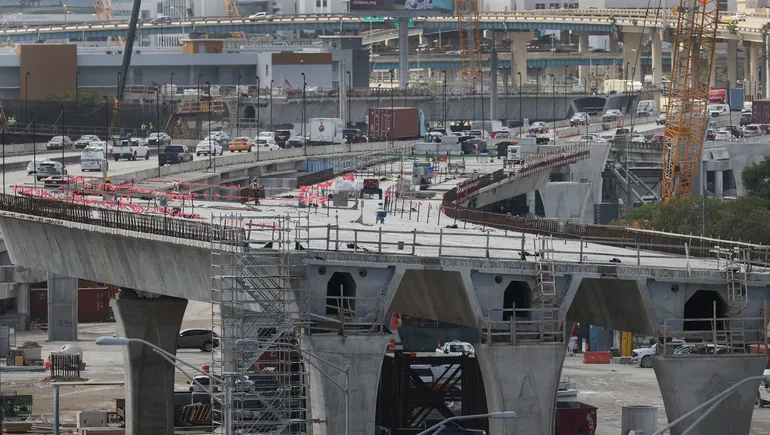Climate advocates have raised concerns about the real-world impact of the 2021 infrastructure law, which could add more than 69 million metric tons of carbon dioxide equivalent to the atmosphere by 2040 based on current spending trends by state transportation departments, according to an analysis by Transportation for America.
The advocacy organization’s policy associate, Corrigan Salerno, explained at a media briefing Feb. 14 hosted by Climate Nexus that the analysis looked at 55,000 projects that states reported to the federal government. “Nearly 25% of the [Infrastructure Investment and Jobs Act] formula dollars, specifically, states are spending towards highway expansion and another quarter is being spent towards highway resurfacing,” Salerno said.
“On the whole, a lot of IIJA money actually risks perpetuating a problematic status quo both because of the law itself and because of the state departments of transportation that are spending these funds,” said Harrison Carpenter-Neuhaus, communications manager at Climate Nexus, during the briefing. “The other big factor here is that state departments of transportation also have wide discretion over where to put their funds.”
Carpenter-Neuhaus pointed out that the former deputy director of planning and modal programs at the California Department of Transportation was demoted and placed on leave when she threatened to file a whistleblower complaint regarding freeway projects that were described as maintenance work but were intended to widen highways.
The Texas Department of Transportation has proposed a $12 billion widening of Interstate 45 in Houston over the objections of dozens of organizations. According to Ally Smither, an organizer with Stop TxDOT I-45, the project would displace 1,079 homes, 344 businesses and five churches. But, Smither said during the briefing, “The real cost of this project is in human lives,” pointing to the noise, air pollution and loss of generational wealth.
Many believe new roads and widened highways create induced demand: more capacity invites more drivers. A classic example of this effect is the widening of Interstate 405 in California along a 10-mile stretch completed in 2015. Four years later, traffic was moving even slower during most rush-hour commutes. The California Department of Transportation acknowledges on its website that “Induced demand creates more traffic at greater cost to people and the environment, while worsening congestion.”
Not everyone agrees. Steven Polzin, a researcher at Arizona State University, argues in a policy brief for the Reason Foundation that traffic volume is also increased by population and employment growth, new activities in the area served by new or expanded roadways and the choice by drivers to switch travel routes and times.
Nevertheless, Transportation for America’s Salerno said at the recent briefing that “for every investment in highway expansion, every other investment in emissions-reducing strategies has to work their way down to get towards a net reduction relative to the baseline emissions that our transportation system was already creating.”
Transportation for America’s projection that the IIJA could add more than 69 million metric tons of carbon dioxide equivalent by 2040 was made prior to the reported possibility that the Biden administration may stretch out emissions standards for passenger vehicles and light trucks that could require 67% of new light-duty vehicle sales be electric vehicles by model year 2032, which several news outlets reported this weekend. The revised rule is expected to look for EVs to account for less than 60% of new vehicles manufactured by 2030, according to sources cited by Reuters.
“Unfortunately the Biden Administration has put all of its transportation decarbonization eggs in the electrification basket, so slow-rolling the EPA vehicle efficiency standards undermines the administration’s decarbonization effort for transportation,” said Transportation for America Director Beth Osborne in an email statement to Smart Cities Dive.
Osborne added that the administration would be better prepared for the uncertainties of the EV transition “If the bipartisan infrastructure bill had invested in shifting our transportation spending from ineffective and damaging highway expansions to roadway repair, bridge replacement, public transit, safe streets and more housing close to jobs and opportunities.”
The U.S. Environmental Protection Agency’s original proposed rule met immediate pushback from the automotive industry and Congress. It also raised concerns for United Auto Workers President Shawn Fain, who wrote to UAW members last year, “The federal government is pouring billions into the electric vehicle transition, with no strings attached and no commitment to workers.”
The UAW initially held off endorsing President Joe Biden for reelection. According to The Washington Post, the EPA sent the final rule to the administration in January, and the UAW endorsed Biden shortly after.
